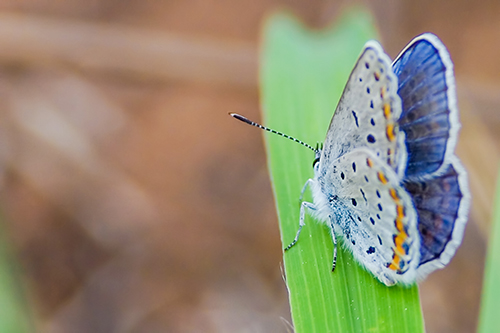Pollinator Spotlight: The Karner Blue Butterfly
The Karner blue butterfly, scientifically known as Lycaeides melissa samuelis, belongs to the Lycaenidae family, commonly referred to as gossamer-winged butterflies. This delicate creature is a symbol of grace and beauty in Wisconsin's natural landscapes.
Measuring about the size of a nickel, with a wingspan of approximately one inch, the Karner blue butterfly bears distinctive features that aid in its identification. Its top side exhibits a sky blue hue in males, while females showcase a darker blue and brown palette, complemented by vibrant orange spots along the edges of both hind wings. Moreover, both genders flaunt bands of orange crescents on the undersides of their fore and hind wings, a unique trait that distinguishes them from other small blue butterflies.

Historically, the Karner blue butterfly inhabited a vast range spanning from Minnesota to Maine and into Canada. However, habitat loss, fragmentation, and destruction have significantly diminished its populations. Today, outside of Wisconsin, the Karner blue persists in small pockets across Indiana, Michigan, Minnesota, New Hampshire, and New York. Sadly, it has been extirpated in states like Massachusetts, Pennsylvania, Ohio, and Ontario. As of December 2023, 637 observations of the Karner Blue Butterfly exist on iNaturalist for Wisconsin. This is WPW’s call to action to increase observations to enhance our understanding of the butterfly's location, population, and habits, ultimately contributing to improved conservation efforts!
In Wisconsin, the Karner blue finds refuge in open barrens, savannas, and prairies where wild lupine thrives. These habitats, prevalent in central and northwest Wisconsin, serve as vital ecosystems for the butterfly's survival. Wild lupine, the primary food source for Karner blue caterpillars, is essential for sustaining their populations. Additionally, Karner blues may also inhabit areas like roadsides, utility right-of-ways, and other open early successional stages, providing crucial corridors for dispersal and genetic diversity.

Given its dwindling populations and restricted habitats, conservation efforts are paramount for the Karner blue butterfly's survival. Organizations and agencies in Wisconsin are actively involved in habitat restoration projects, including the preservation and enhancement of lupine-rich environments. These initiatives aim to safeguard not only the Karner blue but also other native species dependent on similar habitats.
References
"Wisconsin butterflies" Retrieved 2024-01-23 https://wisconsinbutterflies.org/butterfly/species
Photo reference https://www.iceagetrail.org/wp-content/uploads/Spring-2018-MT-pXX-XX-Land-Conservation-highlights-Photo-2-Steve-Apps-Karner-blue-butterfly.jpg







Comentarios
Agregar un comentario